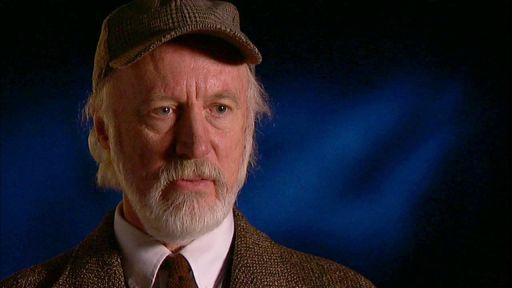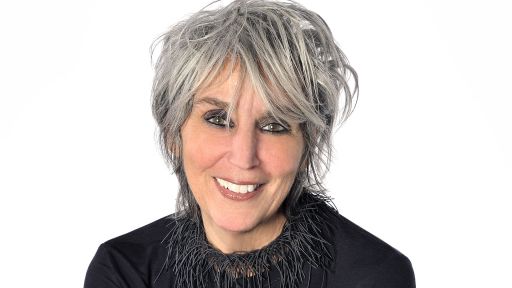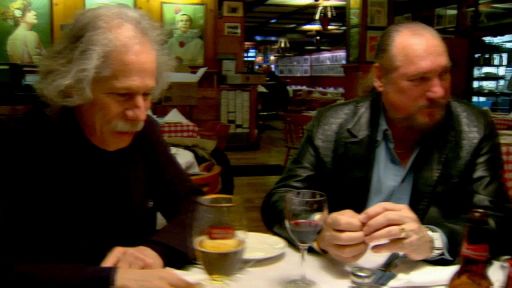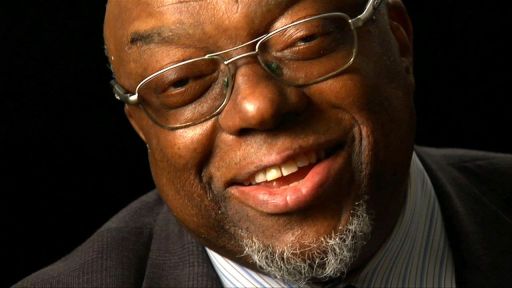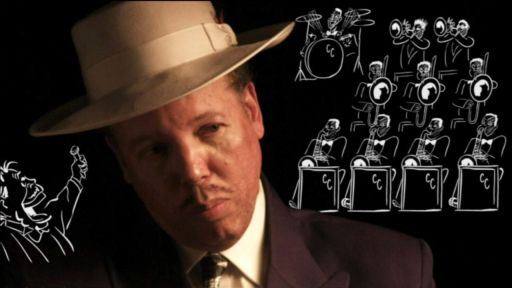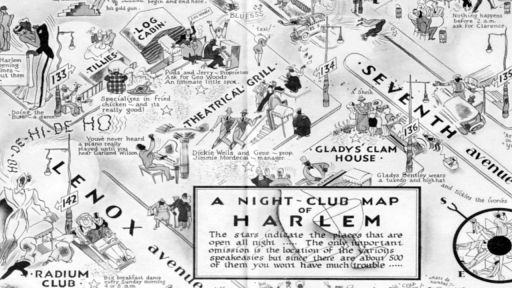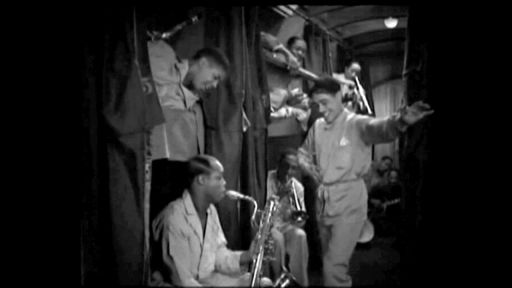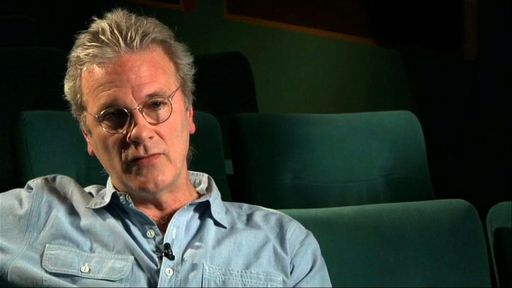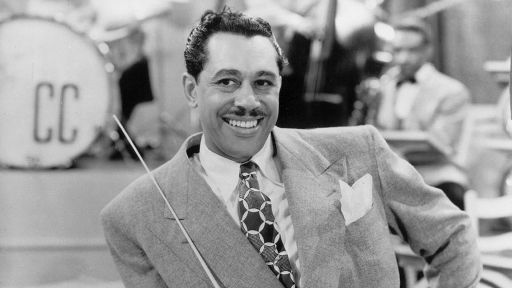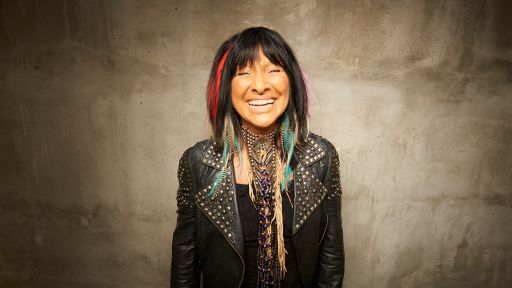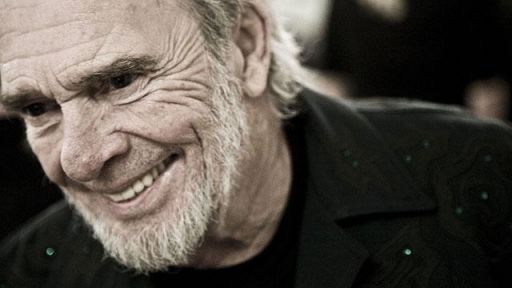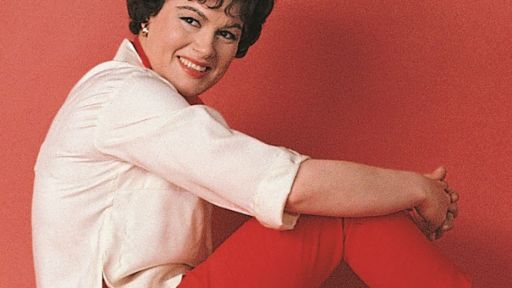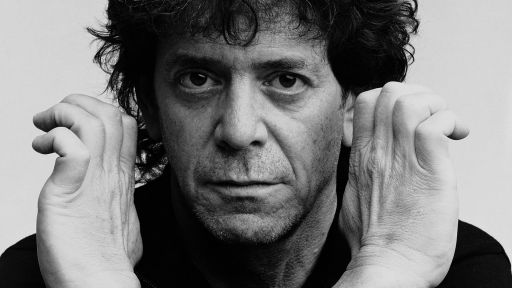There he is: on-stage alone, elderly, confronted with a young audience waiting for other artists. To keep them from getting antsy, he turns to the orchestra and leads them into an old song. As he performs Minnie The Moocher, everything is transformed: the stage turns into a jazz cabaret, the orchestra dons tuxedos and acquires big-band-style music stands, and the singer metamorphoses into an elegantly untamed entertainer, garbed in white tie and tails. On screen, Cab Calloway conquers an astonished audience, enthusiastically singing along with his repeated salvos of Hi de Ho…
That’s how, in 1980, Cab Calloway was (re)discovered by a new generation, in a filmed tribute to black music, The Blues Brothers.
Long-term jazz fans, young initiates or blossoming rappers would be filled with the spirit of the last living jazz legend.
For almost 15 years, right to the end, Cab Calloway would travel the world singing Minnie The Moocher – a song he performed for the first time back in 1931.
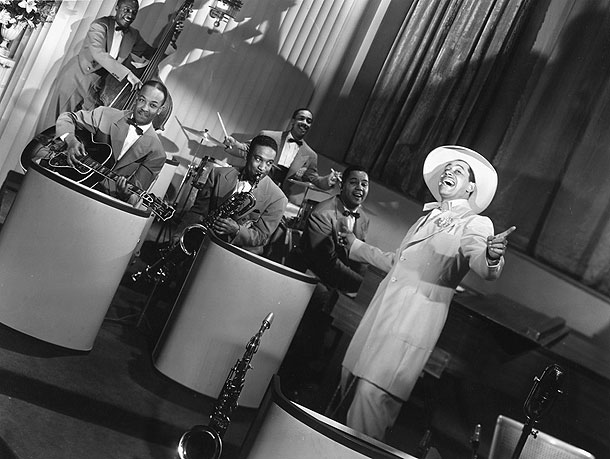
Cab Calloway in Stormy Weather (1943). Image courtesy of Artline Films / J.-F. Pitet.
Cab Calloway’s early career
Yet this consummate performer’s life started in the streets of Baltimore – tending horses at the racetracks, delivering newspapers or looking for trouble with local gangs. The king of “Hi de Ho” started out as a little punk, determined to cut classes and not to study law as his mother would have wished. He preferred singing –in church or in the street with the little quartet he’d founded. His career began to gather momentum when his older sister Blanche, who had already performed with Louis Armstrong, came through Baltimore on tour. It was the little nudge from fate he needed to get into the Plantation Days revue, and to make it to Chicago with that company. In the Windy City’s Sunset Café, he began to attract serious attention for his uniquely exciting performances: the way he moved on stage, jumped up on tables and more… To the point that a band that happened to be in town fired their own leader and hired Cab instead! The Alabamians headed for New York with a contract for the famed Savoy Ballroom in their pockets. But from the first night, the house band wiped the floor with them. Still, the audience, which also voted for best band leader, picked Cab, who was offered the job of conducting the winners: the Missourians. Once again, thanks to Cab Calloway, they caught the attention of Duke Ellington’s agent, Irving Mills.
At the time, Ellington was playing at the Cotton Club. The prestigious Harlem nightclub was run by gangsters who “invited” Cab Calloway to replace Ellington while he was on tour… and threatened to trash whatever other venue Cab was supposed to be playing to make the offer harder to refuse!
Suddenly, the young Cab Calloway (barely 23 then, in early 1930) was the new star of the Cotton Club, the chic place for rich white people to enjoy the twin thrills of slumming in Harlem and taking in the elegant, sexy revues performed by stunning and scantily clad black showgirls… and by Calloway’s band. He soon became the darling of journalists and of New York’s nightlife. The radio quickly caught on to the phenomenon, broadcasting his shows three times a week: the United States had discovered Cab Calloway, and he was an overnight success.
Cab Calloway’s popularity and success
Thanks to Minnie The Moocher and its endlessly scatted chorus of “Hi de Ho’s”, Cab Calloway became the first black performer to sell a million copies of a 78 record! Oddly enough, the upbeat sounding song actually tells the tale of a poor girl under the thumb of a pimp who cares more about coke than love. Calloway’s repertory gradually expanded to include songs about drugs (Kicking the Gong Around, The Reefer Man…). Even if the crowds didn’t always grasp the songs’ meaning, they fell under the spell of the rhythm and of Cab Calloway’s ever-wilder performances. It should be pointed out that Cab totally stood out from other band leaders of his day, who did no more than limply wave their batons to the beat and smile at the audience. Cab always went a step further, shaking his unkempt hair, grimacing through his scats, and dancing, well… to beat the band! He was never boring, tending, if anything, towards overdoing it!
Be that as it may, his success literally knew no bounds. His popularity was such that his was the first black band to be invited onto the The Lucky Strike Show on the radio, and even more amazingly, the first one of its stature to tour the southern states. Even though he was Cab Calloway, applauded by ever-larger crowds at every stop, the tension was tremendous. And both insults and threats rained down. The hateful beat of segregation and Jim Crow was stronger than the music. Audiences were usually segregated, with the Black and White seats separated by a rope, or else back-to-back concerts were given, one for each “color.”
Swearing that he wouldn’t put himself through that kind of humiliation ever again, Cab decided that from then on, he would tour with a specially chartered Pullman train that would keep his band members safe and guarantee them a decent place to sleep wherever they went, as they weren’t allowed into white hotels.
His 1934 European tour (England, Holland, Belgium and Pleyel Hall, Paris) proved that his popularity transcended borders, although the critics were surprised by this out of the ordinary band leader’s stage antics.
Cab Calloway in Hollywood
With his stage and radio success, it didn’t take Hollywood long to realize the advantages of bringing Cab Calloway to the screen. It started with short films of his songs, but he was soon sharing top billing with Bing Crosby (The Big Broadcast, 1932) and Betty Boop in three cartoons where he is portrayed variously as a walrus, a ghost and an old hermit. His manic gesturing was heaven sent for cartoon animators, who portrayed him in a million guises: as a spider, frog, cricket, pig, cat, rooster and more… All in all, Cab Calloway appeared in over 35 cartoons, making him the most frequently seen black person in animation!
This exploitation went beyond caricature: it concerned the music, too. Benefiting from what black musicians had created, numerous white bands gradually began developing a slightly straiter-laced form of jazz. It was the acme of Swing, with the rise of the Dorsey Brothers, Woody Herman, Benny Goodman and more…
But his good looks and talent kept Cab Calloway in the spotlight: The Singing Kid (1936) with Al Jolson (the (in)famous black-faced “Jazz Singer”), Manhattan Merry-Go-Round (1937), Sensations of 1945, Hi de Ho (1947) and above all, Stormy Weather (1943) in which a full cast of black performers brings the history of jazz to life. The latter film starred Bill Robinson, Fats Waller, Lena Horne, and in the grand finale, Cab Calloway, surrounded by the celebrated tap dancers the Nicholas Brothers, in “the most greatest dance number ever filmed” (dixit Fred Astaire).
Tours, revues, shows and studio recording followed at a quick pace, but the end of the war was also the end of the Golden Age of big bands. The rise of be-bop, and audience’s evolving tastes, brought changes to the music scene, and big bands gradually fell out of fashion. The biggest star of the 30s and early 40s was reduced to chasing after gigs. By April 1948, Cab Calloway was the king of hi-de-ho in name only: he was obliged to disband his troupe, and had to go looking for gigs as far afield as Cuba and South America. The showman who once traveled the world with a 50-man orchestra now had just 6 musicians by his side.
Cab Calloway’s later career
Fortunately, the hard times were leavened by occasional successes: in 1952, Calloway was offered the role of Sportin’ Life, in Gershwin’s opera Porgy and Bess. Cab Calloway once again tasted the thrill of packed houses, international tours and top billing. The show enjoyed almost two and a half years of uninterrupted success.
Another eclipse followed that interlude, broken up by touring with the Harlem Globetrotters basketball team. He would perform at half-time with just a single pianist. He tried to get back into the spotlight with a show called Cotton Revue 1958, but audiences didn’t materialize. He didn’t give up, and managed to remain a household name thanks to TV appearances and the occasional concert here and there, in the USA and Europe.
The black version of Hello Dolly brought a new state of grace in 1968. The show was a triumph for both Cab Calloway and his old friend Pearl Bailey. Other Broadway musicals gave him top billing again: The Pajama Game – (a flop) (att’n aux parens en vo), Bubbling Brown Sugar… and then it was back to small venues and nightclubs, accompanied by his daughters (Cecelia or Chris).
Cab Calloway’s Rennaissance
The late 70s saw a revival for jazzmen from the Golden Age: they were getting recognition once again… but it had to be quick, as they were elderly and starting to pass away! Jazz festivals – especially in Europe – welcomed them, putting them back in the limelight. And so it came to pass that in 1977, Cab Calloway reformed an orchestra with several of his former musicians, playing noteworthy concerts in France, Germany and elsewhere. From then on, he came back almost every year, worshipped by old fans… and new ones, thanks to his role in John Landis’s The Blues Brothers (1980). Suddenly, Cab Calloway was back in the spotlight once again: concerts and tours kept him traveling the world (including Japan). As he had said way back in the 30s, he would only leave the stage feet first! And so it came to pass that Cab Calloway’s final years were spent before adoring audiences, thrilled by an elderly musician who still performed his life-long hits with all the energy of his youth. And of course, the highlight was always Minnie the Moocher, when everyone sang along!
Cab Calloway passed away a few months after a stroke. His farewell concert was performed seated, before an admiring audience.
He was also admired by all those who were influenced and inspired by his talent. From Louis Prima, Louis Jordan, Sammy Davis Jr. and Billy Eckstine, to Prince, Joe Jackson, Janet and Michael Jackson, Tupac Shakur, Alicia Keys, Kid Creole and the Coconuts and Big Bad Voodoo Daddy… they all acknowledge Cab Calloway as a tremendous artist, a first-class entertainer and a veritable one-man showman. An icon of jazz.
As an angel in a 1937 cartoon (Clean Pastures) Cab Calloway leads the parade, with everyone following behind…


